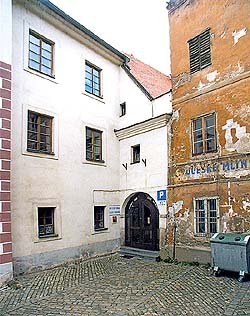Široká No. 79
Description of the Building:
This used to be originally an inhabitable house, then was later
changed into the town granary. The Rennaissance front is partly
covered by the outlying house at Široká
No.78. The original carriageway to Široká street, seen from the
uncovered part of the house, creates the entrance to both houses
No. 78 and 79. All the inner construction of the house used to be
originally made of wood, but was completely changed during the last
radical reconstruction in the 1980s. The bottom part of the rear
elevation is created by a moat town wall. On the outer side of the
wall on the left is situated a one-storey building, vaulted with
barrel-vaults with or without lunettes on the ground and first
floors. It used to be probably a bastion of the medieval
fortification.
Architectural and Historical Development:
This was originally an inhabitable house. Its existence was first
documented at the beginning of the 16th century. In the middle of
the 17th century it was bought by the town council for public
purposes and a town granary was established there, then the house
was completely rebuilt for this purpose. As for the style of the
building, we can classify it among out-buildings, which were built
for the town by Domenico
Benedetto Cometta z Eckthurnu. Today the inner layout
completely differs from the original due to the last reconstruction
in the 1980s.
Significant Architectural Features:
A moat town wall going through the rear elevation of the house.
 History of the House
Residents:
History of the House
Residents:
From the beginning of the 1520s the house belonged to Jan Sumreir,
then after his death in 1566 it was the property of his family
until 1571. Václav Trubačka came there in that time, followed by
Kryštof Kastner, called Trubačka, who owned it until 1587. Then
Ambrož Kurzweil moved there. A furrier Lorenc Bruderle bought the
house from him in 1590. Lorence´s widow Alžběta sold it in 1597 to
Jan Kubíček. After his death in 1603 a soap-maker Blažej Tanzl
bought the house and owned it to the second decade of the 17th
century. In the mid 17th century the house was bought by the town
council for purposes of the town. It was used as a granary and
there was a flat of a municipal footman. In 1774 it served to
stable draught horses and to store carriages and fire-engines which
belonged to the town. From the beginning of the 19th century the
house was rented to the imperial supply magazine and to private
persons.
Present Use:
There are some offices of the Český
Krumlov Municipal Authority.


